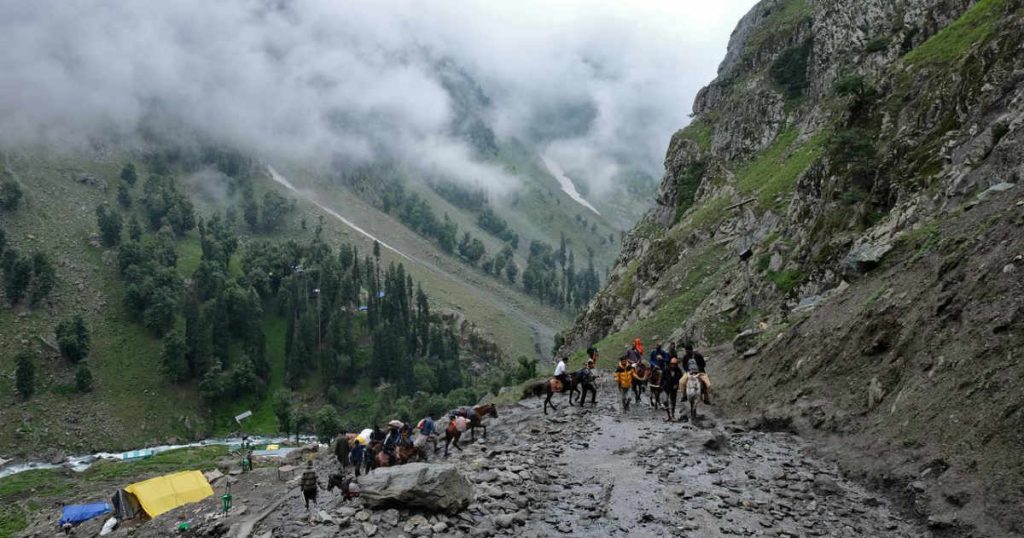Udhampur, nestled in the northern reaches of India’s Jammu and Kashmir union territory, boasts a diverse and captivating weather spectrum. Positioned amidst the picturesque Shivalik range of the Himalayas, the town experiences distinct seasons that contribute to its unique climate. During the summer months from March to June, Udhampur witnesses moderately warm temperatures, reaching up to 30-35 degrees Celsius. The monsoon season, spanning July to September, brings a moderate amount of rainfall, transforming the landscape into a vibrant green haven. Autumn, gracing the months of October and November, marks a transition to cooler weather, accentuated by the changing hues of the foliage.

Weather in Udhampur: Today
| Date | Day/Night | Conditions | High (°C) | Low (°C) |
|---|---|---|---|---|
| Today (26 Dec) | Day | Mostly Cloudy | 22 | 11 |
| Night | Generally Clear | – | 11 | |
| 27 Dec | Day | Partly Cloudy | 23 | 12 |
| Night | Clear | – | 10 | |
| 28 Dec | Day | Sunny | 24 | 13 |
| Night | Clear | – | 10 | |
| 29 Dec | Day | Mostly Sunny | 25 | 14 |
| Night | Partly Cloudy | – | 12 | |
| 30 Dec | Day | Partly Cloudy | 24 | 13 |
| Night | Partly Cloudy | – | 11 | |
| 31 Dec | Day | Partly Cloudy | 23 | 12 |
| Night | Mostly Cloudy | – | 10 | |
| 1 Jan | Day | Cloudy | 22 | 11 |
| Night | Cloudy | – | 9 | |
| 2 Jan | Day | Partly Cloudy | 23 | 12 |
| Night | Partly Cloudy | – | 10 |
Seasonal Changes in Udhampur Weather
Udhampur undergoes distinct seasonal changes, each contributing to the town’s diverse and captivating weather patterns.
1. Summer (March to June):
- During the summer months, Udhampur experiences a moderately warm climate.
- Daytime temperatures can range from mild to moderately high, typically reaching 30-35 degrees Celsius.
- Evenings are generally pleasant, providing a respite from the daytime heat.
2. Monsoon (July to September):
- The monsoon season in Udhampur brings a moderate amount of rainfall.
- The region becomes lush and green during this period, adding to its natural beauty.
- However, occasional heavy rainfall can lead to landslides in the hilly terrain, impacting transportation.
3. Autumn (October to November):
- Autumn marks a transition period characterized by cooler temperatures.
- The landscape transforms as the leaves change colors, creating a picturesque setting.
4. Winter (December to February):
- Winter is the coldest season in Udhampur, with temperatures often dropping to near freezing or below.
- Snowfall is common in the higher elevations, enhancing the scenic beauty of the surroundings.
- Warm clothing is essential during this season, especially in the elevated regions.
Extreme Weather Events
Udhampur, like many regions, is susceptible to various extreme weather events that can significantly impact its environment and daily life. While the town generally experiences a diverse climate, certain events can bring about unusual and extreme weather conditions. Here are some examples:
1. Heavy Snowfall:
- Udhampur, situated in the Himalayan region, is prone to heavy snowfall during the winter months, especially in higher elevations.
- Extreme snowfall can lead to road blockages, affecting transportation and disrupting normal activities.
2. Monsoon-Related Landslides:
- The monsoon season, from July to September, brings moderate to heavy rainfall.
- Intense and prolonged rainfall can trigger landslides in the hilly terrain, impacting infrastructure and posing safety risks.
3. Flash Floods:
- Sudden and heavy downpours, particularly during the monsoon season, can lead to flash floods in Udhampur.
- Flash floods can result in the overflow of rivers and streams, causing damage to property and affecting local communities.
4. Heatwaves:
- While Udhampur generally experiences moderate temperatures, occasional heatwaves during the summer months can lead to unusually high temperatures.
- Extended periods of extreme heat may pose health risks and impact agriculture.
5. Cold Waves:
- Winter in Udhampur can bring cold waves, with temperatures dropping significantly.
- Prolonged cold waves can affect daily life, especially in terms of transportation and heating requirements.
Agricultural Impact Udhampur Weather
The weather in Udhampur significantly influences agricultural practices in the region, shaping the patterns of cultivation and impacting crop yields. Here’s an overview of the agricultural impact of Udhampur’s weather:
1. Seasonal Crop Rotation:
- The distinct seasons in Udhampur, including summer, monsoon, autumn, and winter, influence the types of crops that can be grown.
- Farmers often engage in seasonal crop rotation to optimize the use of available resources and adapt to changing weather conditions.
2. Relying on Rainfall:
- Agriculture in Udhampur is largely dependent on rainfall, especially during the monsoon season.
- Adequate and well-distributed rainfall is crucial for the cultivation of various crops, and variations in rainfall patterns can impact yields.
3. Impact of Snowfall:
- Snowfall during the winter months can affect the agricultural landscape, especially in higher elevations.
- While some crops may benefit from snow as a protective layer, excessive snow can hinder access to fields and pose challenges for farmers.
4. Temperature Extremes:
- Extreme temperatures, whether in the form of heatwaves during summer or cold waves during winter, can affect crop growth.
- Frost during winter months can be detrimental to certain crops, while excessive heat can stress plants during the growing season.
5. Challenges in Transportation:
- Extreme weather events, such as heavy snowfall or landslides during monsoons, can disrupt transportation routes to and from agricultural areas.
- This can impact the timely transportation of produce to markets, affecting the livelihoods of farmers.
6. Water Management:
- Efficient water management becomes crucial, especially during periods of low rainfall or drought.
- Farmers may need to implement irrigation systems to ensure the adequate hydration of crops, particularly in drier seasons.
7. Adaptation Strategies:
- Farmers in Udhampur often employ adaptive strategies, such as selecting weather-resistant crop varieties, implementing water-saving techniques, and using organic farming practices.
Local Weather Forecast Services
Udhampur, like many regions, likely relies on local weather forecast services to provide timely and accurate information about the atmospheric conditions. These services play a crucial role in helping residents, businesses, and authorities make informed decisions based on upcoming weather patterns. Here’s an overview of the typical local weather forecast services in the Udhampur region:
1. Meteorological Department:
- The Meteorological Department of India is a key source for weather forecasts at the national and regional levels.
- Local branches or stations may provide specific forecasts for Udhampur, including details on temperature, precipitation, and other relevant weather parameters.
2. Weather Apps and Websites:
- Many people in Udhampur likely use weather apps and websites that offer real-time and future forecasts.
- Popular platforms provide hourly, daily, and extended forecasts, along with features like radar images and severe weather alerts.
3. News Channels:
- Local and national news channels often include weather segments, providing brief forecasts for Udhampur and surrounding areas.
- These forecasts may be part of regular news broadcasts or dedicated weather segments.
4. Community Radio Stations:
- Community radio stations in Udhampur may offer localized weather updates to cater to the specific needs of the community.
- These stations might provide information on weather conditions, road closures, and safety measures during extreme weather events.
5. SMS and Mobile Alerts:
- Some weather services offer SMS alerts or mobile notifications for subscribers, providing instant updates on changing weather conditions.
- This method is particularly useful for timely communication of important weather-related information.
6. Local Weather Stations:
- In addition to national and regional services, there may be local weather stations or networks in Udhampur that cater to the specific nuances of the area’s climate.
- These stations might focus on hyper-local forecasts and weather-related challenges unique to the region.
7. Social Media Platforms:
- Social media platforms can be a quick and accessible source of weather information.
- Local authorities or weather enthusiasts may share updates, photos, and forecasts on platforms like Facebook and Twitter.
Unique Climate Features
Udhampur’s geographical location in the Shivalik range of the Himalayas contributes to several unique climate features that distinguish it from other regions. Here are some notable aspects of Udhampur’s climate:
1. Himalayan Influence:
- Udhampur’s proximity to the Himalayan mountains imparts a distinctive character to its climate. The elevation and the surrounding mountainous terrain contribute to cooler temperatures compared to the plains.
2. Diverse Seasons:
- Udhampur experiences four distinct seasons — summer, monsoon, autumn, and winter. Each season brings about noticeable changes in temperature, precipitation, and overall weather conditions.
3. Temperature Extremes:
- The region encounters temperature extremes, with warm summers reaching moderate highs and cold winters featuring temperatures dropping to near freezing or below. This temperature range is influenced by the altitude and the surrounding mountainous landscape.
4. Monsoon Dynamics:
- The monsoon season in Udhampur brings moderate to heavy rainfall, transforming the landscape into lush greenery. However, the hilly terrain makes the region susceptible to landslides during intense rainfall.
5. Snowfall in Winter:
- Winter in Udhampur often sees snowfall in the higher elevations, creating a winter wonderland effect. The snow-capped peaks add to the scenic beauty of the region.
6. Agricultural Variability:
- The diverse climate allows for the cultivation of a variety of crops. Seasonal changes influence the types of crops grown, and agricultural practices are adapted to the different weather patterns.
7. Impact on Biodiversity:
- Udhampur’s climate has a significant impact on its biodiversity. The unique combination of elevation, temperature variations, and precipitation levels supports a variety of flora and fauna adapted to the mountainous environment.
8. Cultural Significance:
- The climate of Udhampur has cultural significance, influencing local traditions, festivals, and daily life. The changing seasons often play a role in community celebrations and rituals.
9. Tourism Appeal:
- The diverse climate and picturesque landscapes make Udhampur an attractive destination for tourists. Visitors are drawn to the region for its natural beauty, which is accentuated by the unique climate features.
Conclusion
Udhampur’s climate is a tapestry woven with the unique threads of its Himalayan locale, offering a distinctive and diverse atmospheric experience. The town, nestled in the Shivalik range, witnesses a spectrum of seasons, from the warm embrace of summer to the chilly enchantment of winter. The influence of the surrounding mountains imparts temperature extremes, contributing to the town’s character and impacting agriculture, biodiversity, and cultural practices.
FAQs
The weather in Udhampur today (26 December 2023) is mostly cloudy with a high of 22°C and a low of 11°C.
The weather forecast for Udhampur for the next few days is partly cloudy with highs in the mid-20s (°C) and lows in the low-10s (°C).
The best time to visit Udhampur is during the spring (March to May) or fall (September to November) when the weather is mild and pleasant.




















